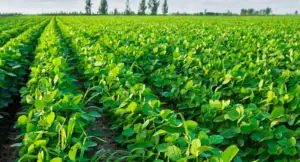The preparation of soil is the first step before growing a crop. One of the most important tasks in agriculture is to turn the soil and loosen it. This allows the roots to penetrate deep into the soil. The loose soil allows the roots to breathe easily, even when they go deep into the
soil.

Soil preparation is an essential step in crop production that involves preparing the soil to create optimal conditions for plant growth. It aims to improve soil structure, fertility, and drainage, and to remove weeds, pests, and diseases. Proper soil preparation provides a favorable environment for seeds or seedlings to establish roots, access nutrients, and flourish.
Some of the key steps involved in soil preparation for crop production are explained below:
- Clearing the land: Start by removing any existing vegetation, such as weeds or crop residues, from the planting area. This can be done manually or by using machinery like plows or tillers.
- Soil testing: Conduct soil tests to assess its nutrient content, pH levels, and organic matter. This information helps determine the specific soil amendments needed to optimize fertility and pH balance. Soil testing also identifies any nutrient deficiencies or imbalances that may require correction.
- Soil amendment: Based on the soil test results, add necessary amendments to improve soil fertility. Common soil amendments include organic matter (compost, manure), lime (to adjust pH), and additional nutrients (nitrogen, phosphorus, potassium) through fertilizers. Incorporate these amendments into the soil by tilling or mixing them thoroughly.
- Soil tillage: Tillage refers to the mechanical manipulation of the soil to improve its structure and texture. It helps break up compacted soil, increase aeration, and create a loose seedbed for planting. The extent of tillage depends on the crop being grown, soil type, and farming practices. It can range from shallow cultivation to deep plowing, with appropriate equipment like plows, harrows, or rototillers.
- Weed control: Remove or suppress weeds before planting to prevent competition for nutrients, water, and light. This can be done through mechanical methods like hand weeding or using machinery such as cultivators. Alternatively, herbicides may be used, following recommended guidelines and safety precautions.
- Soil moisture management: Adequate soil moisture is crucial for crop growth. Ensure the soil has sufficient moisture content before planting. Irrigation or water management practices can be employed to provide optimal moisture levels for the specific crop.
- Bed preparation: Depending on the crop and farming system, the soil may be shaped into raised beds or ridges. These structures improve drainage, prevent waterlogging, and facilitate better root development.
- Mulching: Applying a layer of organic or synthetic mulch on the soil surface helps conserve moisture, suppress weed growth, and moderate soil temperature. Mulching materials can include straw, wood chips, plastic films, or biodegradable alternatives.
Read Also:
- Good agricultural practices, class – 8
- What are crops? & their types, Class 8
- Crop production and management – class 8
By following these steps, farmers can prepare the soil effectively for crop production. It sets the foundation for healthy plant growth, maximizes yield potential, and reduces the risk of pests, diseases, and nutrient deficiencies. It’s important to note that specific soil preparation practices may vary depending on the crop, climate, and local agricultural practices.
Stay tuned with Laws Of Nature for more useful and interesting content.



